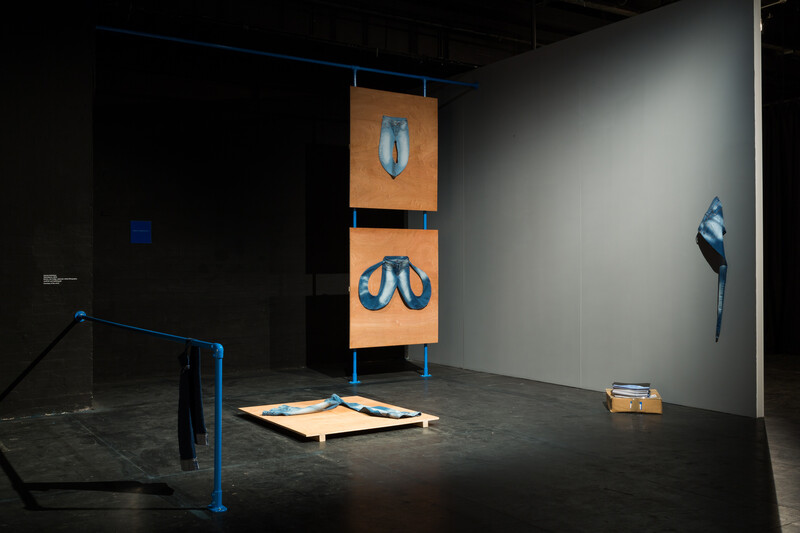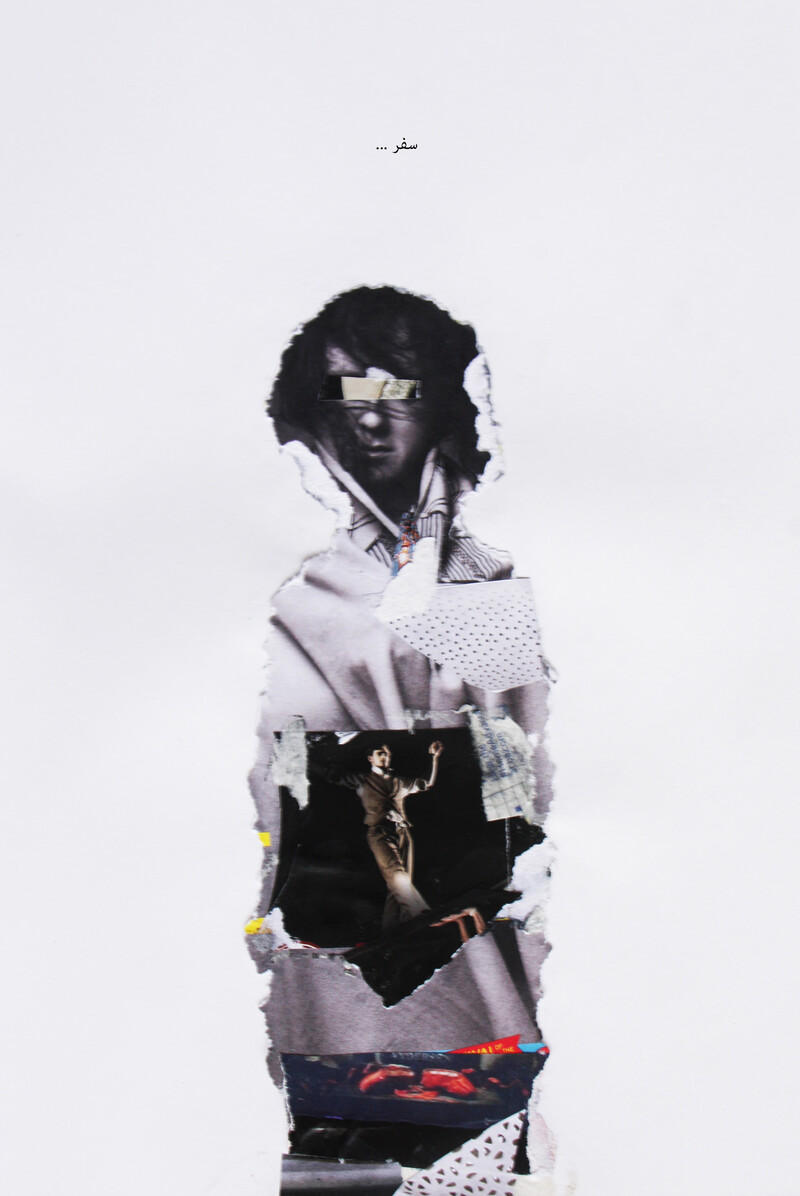The Electronic Intifada 10 July 2013

Basel Abbas and Ruanne Abou-Rahme’s installation The Incidental Insurgents at London’s Institute of Contemporary Arts. (Image courtesy of the artists)
Points of Departure, the Institute of Contemporary Arts’ contribution to London’s Shubbak festival of Arabic arts, is not an ordinary exhibition. Rather than featuring the work of a solo artist, or a selection of pieces picked by a curator, it is the culmination of a year of research, thought and creativity by seven artists based in Palestine and Britain.
The results are effectively six mini-exhibitions, each composed of several pieces in various media. This permits a broad exploration of questions around nationalism, identity, history and place.
As one enters the gallery, the first display is the work of Bisan Abu Eisheh. A map of the Jerusalem region is printed on a blackboard-topped table; a pile of chalks allow viewers to add their own lines, comments and interpretations to what they see, with responses ranging from “this is an illegal settlement” to “blah blah blah.” The artificiality of borders and the imposition of settlements into an evolving geography is highlighted.
Accompanying this are four small screens showing video images of daily life at various sites around Jerusalem. Next to each screen is pasted the corresponding page from the DK Eyewitness guidebook to “Jerusalem, Israel, Petra and Sinai.” The information it offers tourists — foregrounding Jewish history and Israeli narratives of the present situation — contrasts markedly with Palestinian daily life.
Disturbing
The title of Abu Eisheh’s work, “Sorry, Your Search for ‘Palestine’ Produced No Results,” emphasizes the theme of the denial of Palestine — both in the Zionist myth of the “land without a people” and the modern obscuring of Palestinian culture and people in “official” versions of Israeli history.
The work of Jumana Emil Abboud is comprised of brightly-colored, childlike paintings that reference great masters such as Titian, but are also reminiscent of prehistoric rock-carvings. In different ways, the paintings and accompanying short film tackle issues of touch and physicality, featuring dismembered bodies, the Latin motto noli me tangere — “do not touch me” — and the place of the body in culture and folklore.
The depictions employed range from the Bible to Cecil B. DeMille’s Orientalist depictions of “the East” to linguistic references such as the phrase “he has eyes only for you.” The resulting juxtapositions of words and images are often creepy, dramatic and disturbing.
The central point of the exhibition is — perhaps rightly — Basel Abbas and Ruanne Abou Rahme’s viscerally unnerving, intensely-researched The Incidental Insurgents. In a replica study, a jacket and bag hanging over the chair and the insistent ticking of a played-out record revolving on the turntable give the sense that the occupant has just left. On the walls are selections of photographs, newspaper cuttings, posters and other memorabilia referring to a string of historical figures who tread the fine line between revolutionary and bandit.
These start with the Bonnot Gang, an anarchist group which committed bank robberies and killed policemen in early twentieth century Paris. Then we meet Abu Jildeh, nicknamed — with typical Orientalist inaccuracy — the “Dillinger of the Desert,” a rebel who fought the British and Zionist settlers in the Galilee from 1930 to 1934.
Next come Roberto Bolano and Mario Santiago as Arturo Belano and Ulisses Lima in 1970s Mexico, in a section entitled “The Artist as Bandit.” Lima and Belano, fictionalized versions of Chilean novelist Bolano and Mexican poet Mario Santiago Papasquiaro, appear in Bolano’s novel The Savage Detectives as a duo of reprobate artists whose career — which includes a spell in an Israeli jail for Lima — highlights questions about the nature of art and rebellion.

Jeremy Hutchison’s “Fabrications” installation (Image courtesy of the artist)
Perilous thrill
The images, film and accompanying slogans and mottos — “we were lean young wolves, full of pride and thought: dangerous types” or “I acquired bitter experience of that unwritten commandment: be hungry” — evoke the perilous thrill of rebellion and the ambiguous relationships between action and machismo, politics and violence.
This is exaggerated by the setting; the walls papered with images could be the evidence boards of a police investigation, or the clichéd moment in a thriller when the detectives find a serial killer’s hideout, “decorated” with pictures of victims past and future. Has the recently-departed character at the desk left to track down his villains, or flee the authorities?
Jeremy Hutchison’s installation looks at first sight like several pairs of jeans tacked to boards. But on second look it becomes apparent that none of the jeans could be worn — each are sewn in bizarre shapes, with legs curving up to meet one another or tapering to a minute waist. The sense of bizarreness is explained by a tiny plaque at the back of the exhibit, reading “a jeans manufacturer in Palestine is commissioned to manufacture jeans that represent what it is like to manufacture jeans in Palestine.”

Detail of Bashar Alhroub’s “The Road Leads Me To…” (Image courtsey of the artist)
Meanwhile, Bashar Hroub’s response to his residency in the UK is a series of 60 small, similarly-shaped human figures, each neatly framed and composed of torn-up maps, photographs, magazine pages and other scraps of paper. The whole is evocative of the jumbles of paper one might sort through on clearing out a flat or office, burdened with half-obscured memories.
Olivia Plender’s work — the final part of the show — features two empty museum display cases. To one side of them, a video shows a curator explaining the meaning of Tawfiq Canaan’s collection of Palestinian amulets and folklore objects, which predate the Nakba.
But we only see occasional excerpts of the actual video; much of it is faded to white, and the narration is often drowned out by the soundtrack of the second video. This shows a group of young Palestinian actors rehearsing a scene from a play, talking, dancing, chanting and shouting. The interruptions and mismatches of sound and vision raise questions of voice and representation — whose history and “versions” are seen and heard? — a fundamental issue in the cultural politics of modern Palestine.
Editor’s note: Olivia Plender’s first name was misspelled in an earlier version of this article. It now corrected.
Points of Departure runs at the Institute of Contemporary Arts in London until 21 July. Points of Departure is a collaboration between Delfina Foundation, ArtSchool Palestine, the British Council and the Institute of Contemporary Arts (ICA).
Sarah Irving is a freelance writer. She worked with the International Solidarity Movement in the occupied West Bank in 2001-02 and with Olive Co-op, promoting fair trade Palestinian products and solidarity visits, in 2004-06. She is the author of a biography of Leila Khaled and of the Bradt Guide to Palestine and co-author, with Sharyn Lock, of Gaza: Beneath the Bombs.




